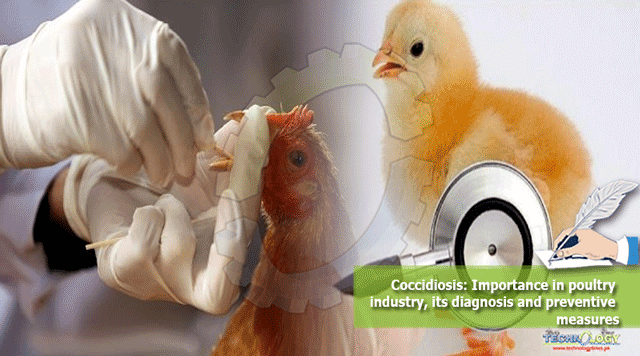In the poultry industry coccidiosis is the most common and expensive disease caused by protozoa belonging to the genus Eimeria that reproduce in the gastrointestinal tract of both healthy and infected birds.

Author: Dr.Maria Jamil1, Dr.Kashif Saleemi1., Dr.Ali Raza2, Dr.Muhammad Tahir Aleem3
- Department of Pathology, Faculty of veterinary science, University of Agriculture, Faisalabad
- Department of Microbiology, Faculty of veterinary science, University of Agriculture, Faisalabad
- MOE Joint International Research Laboratory of Animal Health and Food Safety, College of Veterinary Medicine, Nanjing Agricultural University, 210095 Nanjing, P.R.China
In the poultry industry coccidiosis is the most common and expensive disease caused by protozoa belonging to the genus Eimeria that reproduce in the gastrointestinal tract of both healthy and infected birds. Coccidiosis is mainly the disease of young birds because in adult birds immunity develops after the infection. Due to its direct and short lifecycle, several outbreaks in the poultry industry has been reported.
Clinical signs:
- Intestinal damage
- Bloody diarrhoea
- Dehydration
- Loss of skin pigmentation
- Decreased egg production
- Decreased weight gain and FCR.
Factors contributing to outbreaks:
- Immunosuppression
- Environmental and managemental stress
- Improper feeding and ventilation
- Suboptimal inclusion of anticoccidial
- Wet litter
Transmission:
Sporulated oocysts mechanically spread by wild birds, insects, rodents also by contaminated boots, clothing, equipment and dust.
Species of Eimeria:
These are nine in number, and they are named as
- Eimeria acervuline 6. Eimeria brunette
- Eimeria hagani 7. Eimeria maxima
- Eimeria mitis 8. Eimeria mivati
- Eimeria necatrix Eimeria praecox
- Eimeria tenella
Characteristics for the identification of species:
Different species of Coccidia categorized based on location and appearance of the lesions. Size, shape and colour of the oocyst.
Eimeria acervuline:
Due to Eimeria acervulina in duodenal loop gross white plaques that are arranged transversely. Intestine become pale and having watery and mucoid fluid.
Eimeria brunetti:
It affects duodenal loop but in severe case lesions spread from gizzard to ceca. Coagulated blood and mucous comes in dropping. In its infection villi removed but basement epithelium remains intact.
Eimeria hagani:
It produces lesions in the small intestine and ceca having petechiae and white opacities. In its infection, intestinal contents become creamy or watery.
Eimeria maxima:
It mainly affect the mid-small intestine but in severe cases effects the whole tract of a bird. In its infection abundance of yellow-orange mucus in midgut leads to the ballooning of intestine.
Eimeria mitis: Cause lesions in lower small intestine.
Eimeria mivati: Cause lesions from duodenal loop to ceca.
Diagnosis:
Coccidiosis is easily diagnosed by faecal examination by counting coccidia/gram of faeces, smear preparation. Also, by examining of the intestinal tract to identify the lesion.
Prevention and control of coccidiosis:
Preventive medication is best to avoid losses that occur with the passage of time and treatment. Anticoccidial drugs include sulphonamide, amprolium, Polyether ionophores, Quinoline. Today for the prevention and control of coccidiosis is based on chemotherapy, using anticoccidial drugs, vaccination along with hygienic measures and improved farm management.
Conclusion:
Infections with coccidia cause severe economic losses. Currently, the prevention and control of coccidiosis are based on good hygiene, chemotherapy (Coccidiostats) and immunization. Generally, anticoccidial drugs or vaccination alone is of little value, unless they are accompanied by improvements in all aspects of management. More attention should be given to improved sanitation and hygiene at the farm level. Including, all parameters which can improve litter quality such as; appropriate installation and management of water systems, providing adequate feeding space, maintaining recommended stocking density and supplying adequate ventilation.
